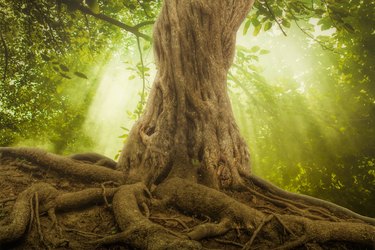
You won't find a dao tree (Dracontomelon dao), also known as the Pacific Walnut tree, growing in the Pacific Ocean-bordering states of the United States. It's a native of East Asia's tropics where rainfall is frequent throughout the year. There are eight species of Dracontomelon growing in the Asian tropics, and the dao is the most plentiful, with a footprint that extends from India to the Solomon Islands. The tree is fast-growing and is used for furniture wood and interior finishes, and the fruit and nuts are edible, but not especially tasty.
Resiliency of Dao Trees
Video of the Day
The Philippines has reported a centuries-old dao tree growing on the campus of the University of the Philippines at Los Banos, southeast of Manila. While leaning at a severe 20-degree angle, the tree has survived numerous typhoons and has been named a Centennial Heritage Tree. Tall and thin, the dao can thrive in well-drained to poorly-drained soil and in clay and stony soil. Dao trees also grow successfully at heights that range from sea level to 3,000 feet. They grow on alluvial flats where the sediment from the hills above nourish the tree, as well as in swampy pastures.
Video of the Day
Dao bears flowers almost year-round but the flower count is higher when the tree is almost leafless and just before the bronze-colored leaves appear. In the Philippines, the dao is considered a vanishing timber, as it also is in Papua New Guinea, due to overharvesting.
Defining Dao Wood
Dao hardwood is defined as lightweight-to-medium-weight. At its heart, the wood is multicolored, with dark brown or black streaks mixing with grey or greenish-yellow or walnut brown grains. The streaked wood makes it highly valuable for woodworking, and imports are continually rising in price as craftsmen adopt this exciting wood for high-end users who are looking for the new and exotic. As it has approximately 15 percent moisture content, the wood needs air drying for two months, or 10 days to dry in a kiln, before it becomes stable.
Some dao trees are evergreen and some are deciduous, with most of the deciduous trees found in the Malaysian Peninsula, Sarawak in the northwest Borneo Island and in Brunei. Pruning occurs naturally with dao trees, making physical pruning almost unnecessary. The sap of the tree can be poisonous for some, but just irritating for others.
Dao Tree Leaves and Uses
Some cultures use the dao tree leaves as a vegetable and the fruit for flavoring foods. Its fruit has medicinal and edible uses, but the sweet-sour taste isn't to everyone's liking. Some use the fruit to add to curries and others coat it in soy sauce and add it to rice. The Malaysians use the fruit as a tart relish that is served with fish. The kernel of the seeds is also edible, while the bark has medicinal uses.
Some cultures plant the dao alongside roads for ornamental landscaping and use the wood for firewood. In tropical China, the fruit is used to cool and subdue itchiness and as an antidote for poisoning. Traditional medicine in some locations use the bark to promote abortions – Indonesians drink a bark-concoction to promote the ejection of the membrane surrounding a fetus or to control dysentery.